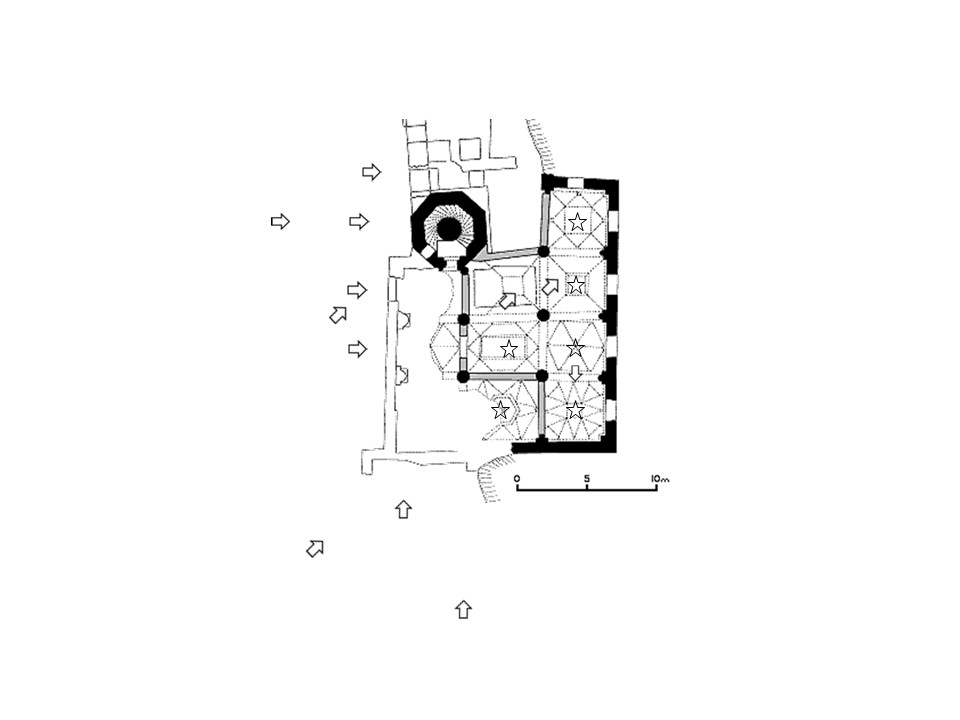Sima Meziridou
The rectangular building known as the Mosque of Minuchihr stands within the main gateway into the citadel of Ani, facing the Akhurian River. It forms part of the original, tenth century city walls of Ashot III, king of Armenia. This building is believed to have been a mosque built by the emir Minuchihr, the first of the Shaddadid dynasty that ruled Ani from around 1072 onwards.
The northeast corner of the original structure appears to have been destroyed for the construction of a tower or minaret, which was later also destroyed and replaced by the octagonal one seen there today. Both were made to fit into the pre-existing rectangular structure with thick red columns. On the collapsed wall of the building facing the street there were three inscriptions carved into the stones, as is evident from old photographs. All three inscriptions could have been carved into the wall at any time after the wall’s construction and they do not necessarily belong together with either the wall’s construction or the building’s function in its original phase.
The first inscription on the structure mentioned the name of emir Minuchihr (1075-1118). It is possible that this inscription was placed there when the building was converted into a mosque, though stylistically, the inscription can be dated earlier than the eleventh century. The second inscription, which was longer than the rest was written in Persian and carved above the first one: it was a yarlīġ inscription, a taxation edict (a firman). It was carved on the mosque after the earthquake in the early years of the thirteenth century. It dated to the period of the Ilkhanid rule of Ebu Sai´d Bahadir (1316-1335). A third, fragmentary inscription in Armenian and Georgian appeared below the aforementioned inscriptions, rather crudely carved, as mentioned by early travellers to the site. All three inscriptions are lost today.
Nikolai Marr argues that the building was a palace built by Ashot III due to the fact that both the city walls and the building are built with the same material, the red stones known as Ashotian. Because of this building’s placement within the city and its design, Veronica Kalas suggests that the building originally functioned as an elite residence or a type of palatial structure or public gathering place for the city. Kalas and Yavuz Özkaya discovered that the Mosque of Minuchihr is a layered building. A scan of the building has shown that the mosque was not purpose built but rather, with some judicious additions, incorporated into an extant building, probably a commercial structure predating the Seljuk period. This explains why the mosque does not have the proper orientation toward Mecca (qibla).
The mosque is a rectangular structure, 18.5 m x 15.7 m. It is spacious, elaborately designed and decorated. The thick red tufa columns and highly decorative polychrome black and red stone tile ceilings with ornate patterns and muqarnas vaults demonstrate a complex mixing of architectural styles that can date anywhere from the eleventh to the thirteenth centuries.
The entrance is at the northern end of the west façade. The interior comprised a rectangular prayer-hall with a roof supported by six freestanding columns that divided the interior space into eleven compartments. Today only six of them survive. The designs of the ceiling over these compartments are different from one another, and are richly decorated with polychrome stone inlays. The columns are short and fat, with capitals bearing muqarnas ornamentation. Underneath the four easternmost compartments is a basement, also with four separate sections, each with a barrel vault. It is said that these rooms were used as burial places for important people. The western wall of the basement is probably older than the rest of the mosque since the vaults of the basement roof are not bonded into it, but merely lean against it.
The prayer hall is lit mainly by five large windows. Four of them have semi-circular arches and one has an ogee arch. There are beam-holes on the exterior façade facing the ravine, above and below the large windows. Above the large windows are smaller rectangular openings whose main purpose was probably to illuminate the decorated ceilings.
At the northwest corner of the mosque stands a minaret, with the Arabic word ‘Bismillah’ written with basalt stones in Kufic lettering high on its northern face. A steep spiral staircase with 93 steps ascends anticlockwise around a central pillar to the top of the minaret. The interior of the staircase is illuminated by one large window and several small ones. The large window may have doubled as an access point to the mosque’s flat roof. The summit is open today and it is believed that originally there would have been a stone parapet.
Image Gallery
Interactive plan

Bibliography
- Heghnar, W. ‘Preserving the Medieval City of Ani: Cultural Heritage between Contest and Reconciliation’, Journal of the Society of Architectural Historians 73:4 (December, 2014), 528-555.
- Eastmond, A., ‘Inscriptions and Authority in Ani’, in: Austay-Effenberger, N. and Daim, F. (eds.), Der Doppeladler. Byznanz und die Seldschuken in Anatolien vom späten 11. bis zum 13. Jahrhundert. Mainz, 2014.
- Marr, N. Ani Knizhnaia istoriia goroda i raskopki na meste gorodishcha (Ani: history of the city according to the literary sources and the excavations of the site of the ancient city) (Leningrad, 1934).
- Rogers, J. M. ‘The Date of the Çifte Minare Medrese at Erzurum’, Kunst des Orients, v. 8 (1972), 77-119.
- Sim, S. ‘VirtualANI – Dedicated to the Deserted Medieval Armenian City of Ani’, available online.
- Kalas V. & Özkaya Y. ‘The Georgian Aspects of Medieval Architecture at Ani in the Thirteenth Century: The Church of Tigran Honents and the Mosque of Minuchir’, Vakhtang Beridze 1st International Symposium of Georgian Culture: Georgian Art in the Context of European and Asian Cultures, June 21-29, 2008, Georgia; Proceedings (Tbilisi, 2009), 211-216.


